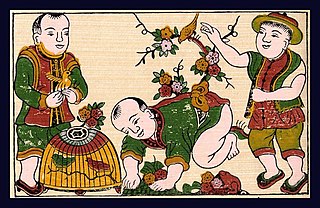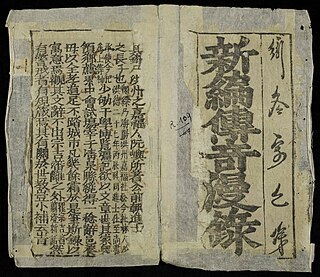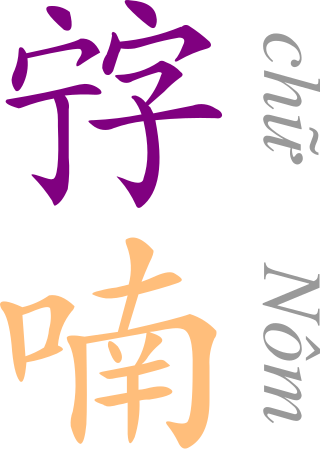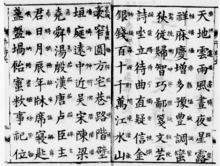Vietnamese literature is the literature, both oral and written, created largely by the Vietnamese. Early Vietnamese literature has been greatly influenced by Chinese literature. As Literary Chinese was the formal written language for government documents, a majority of literary works were composed in Hán văn or as văn ngôn. From the 10th century, a minority of literary works were composed in chữ Nôm, the former writing system for the Vietnamese language. The Nôm script better represented Vietnamese literature as it led to the creation of different poetic forms like Lục bát and Song thất lục bát. It also allowed for Vietnamese reduplication to be used in Vietnamese poetry.

Phan Khôi was an intellectual leader who inspired a North Vietnamese variety of the Nhân Văn–Giai Phẩm affair, in which scholars were permitted to criticize the Communist regime, but for which he himself was ultimately persecuted by the Communist Party of Vietnam.

Vè or Đồng dao is a poetic and song form for children, most typical of Vietnam.

Đăng đàn cung was the royal anthem of the Nguyễn dynasty, Vietnam.

The Truyền kỳ mạn lục is a 16th-century Vietnamese historical text, in part a collection of legends, by Nguyễn Dữ (阮嶼) composed in Classical Chinese. The collection was translated into French by UNESCO in 1962. Nguyễn Thế Nghi (阮世儀) translated this work into Vietnamese. His work is called Tân biên truyền kỳ mạn lục (新編傳奇漫錄).

Daiviet Populist Revolutionary Party, Vietnamese: Đại-việt Duy-dân Cách-mệnh Đảng, Việt Duy-dân Đảng), was a nationalist and anti-communist political party and militant organisation that was active in Vietnam 1943–1947.

Chữ Nôm is a logographic writing system formerly used to write the Vietnamese language. It uses Chinese characters to represent Sino-Vietnamese vocabulary and some native Vietnamese words, with other words represented by new characters created using a variety of methods, including phono-semantic compounds. This composite script was therefore highly complex and was accessible to less than five percent of the Vietnamese population who had mastered written Chinese.

The Six Provinces of Southern Vietnam is a historical name for the region of Southern Vietnam, which is referred to in French as Basse-Cochinchine. The region was politically defined and established after the inauguration of the Nguyễn dynasty, and called by this name from 1832, when Emperor Minh Mạng introduced administrative reforms, to 1867, which culminated in the eight-year French campaign to conquer the Six Provinces.
Lý Thị Ngọc Kiều, dharma name Diệu Nhân (妙因), was a princess during the Lý dynasty in Vietnamese history. She was the 17th leader of the Vietnamese Vinītaruci school of Buddhism.

Đặng Huy Trứ was a Vietnamese official of Nguyễn dynasty.
Đặng Thụy was a Vietnamese official of Revival Lê dynasty.
Nguyễn Phúc Hồng Bảo was a prince of the Nguyễn dynasty, Vietnam.

Chữ Hán is the term for Chinese characters in Vietnamese. Chữ Hán are used to write Literary Chinese and Sino-Vietnamese vocabulary in the Vietnamese language. They were officially used in Vietnam after the Red River Delta region was incorporated into the Han dynasty and continued to be used until the early 20th century where usage of Literary Chinese was abolished alongside the Confucian court examinations causing chữ Hán to fall into obscurity.

The seals of the Nguyễn dynasty can refer to a collection of seals specifically made for the emperors of the Nguyễn dynasty, who reigned over Vietnam between the years 1802 and 1945, or to seals produced during this period in Vietnamese history in general.

The government of the Nguyễn dynasty, officially the Southern dynasty and commonly referred to as the Huế Court, centred around the emperor as the absolute monarch, surrounded by various imperial agencies and ministries which stayed under the emperor's presidency. Following the signing of the Patenôtre Treaty the French took over a lot of control and while the government of the Nguyễn dynasty still nominally ruled the French protectorates of Annam and Tonkin, in reality the French maintained control over these territories and the Nguyễn government became subsidiary to the administration of French Indochina. During World War II the Japanese launched a coup d'état ousting the French and establishing the Empire of Vietnam which was ruled by the Nguyễn government. During the August Revolution the Nguyễn government was abolished in the aftermath of World War II.
The Tale of Từ Thức Marrying a Goddess or Từ Thức Meeting Gods is a Vietnamese legend told in Truyền kỳ mạn lục by Nguyễn Dữ in the 16th century and based on the Folktale of Từ Thức Cave. It follows the life of Từ Thức in the Trần dynasty who meets and marries a goddess in the godly realm before leaving his wife to revisit his hometown, unaware that countless ages have passed in the mortal world since then.

During the Nguyễn dynasty period (1802–1945) of Vietnamese history its Ministry of Education was reformed a number of times, in its first iteration it was called the Học Bộ, which was established during the reign of the Duy Tân Emperor (1907–1916) and took over a number of functions of the Lễ Bộ, one of the Lục Bộ. The Governor-General of French Indochina wished to introduce more education reforms, the Nguyễn court in Huế sent Cao Xuân Dục and Huỳnh Côn, the Thượng thư of the Hộ Bộ, to French Cochinchina to discuss these reforms with the French authorities. After their return the Học Bộ was established in the year Duy Tân 1 (1907) with Cao Xuân Dục being appointed to be its first Thượng thư (minister). Despite nominally being a Nguyễn dynasty institution, actual control over the ministry fell in the hands of the French Council for the Improvement of Indigenous Education in Annam.

The 13th Central Committee of the Communist Party of Vietnam (CPV) has been in session since the conclusion of the 13th National Congress in 2021. It elected, at its 1st Plenary Session, the Politburo, about half of the membership of the Secretariat and the Central Inspection Commission of the 13th term.

Tam thiên tự is a Vietnamese text that was used in the past to teach young children Chinese characters and chữ Nôm. It was written around the 19th century. The original title of the text was originally Tự học toản yếu The book was believed to be complied by Ngô Thì Nhậm ; courtesy name, Hy Doãn.
















